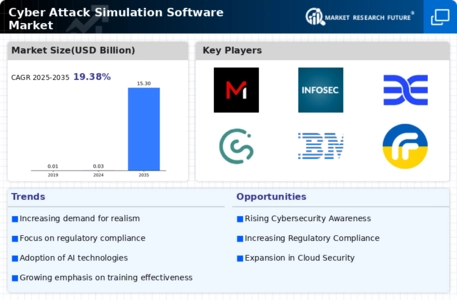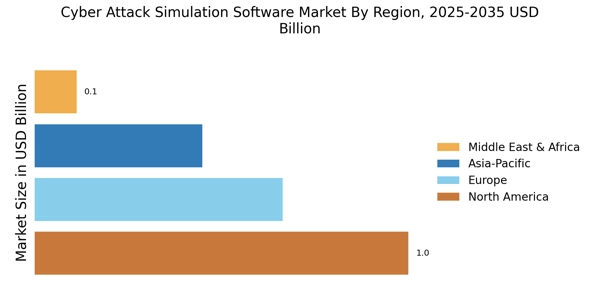Rising Cyber Threat Landscape
The Cyber Attack Simulation Software Market is experiencing heightened demand due to the escalating frequency and sophistication of cyber threats. Organizations are increasingly recognizing the necessity of proactive measures to safeguard their digital assets. In 2025, it is estimated that cybercrime will cost businesses over 10 trillion dollars annually, underscoring the urgency for effective security solutions. This alarming trend compels enterprises to invest in cyber attack simulation software, which allows them to identify vulnerabilities and enhance their incident response strategies. As cyber threats evolve, the need for continuous testing and improvement of security protocols becomes paramount, driving growth in the Cyber Attack Simulation Software Market.
Regulatory Compliance Requirements
The Cyber Attack Simulation Software Market is significantly influenced by the stringent regulatory landscape that mandates organizations to adhere to various cybersecurity standards. Regulations such as GDPR, HIPAA, and PCI DSS require businesses to implement robust security measures to protect sensitive data. Non-compliance can result in severe penalties, prompting organizations to adopt cyber attack simulation software as a means to demonstrate compliance and mitigate risks. In 2025, the market for compliance-related cybersecurity solutions is projected to reach 30 billion dollars, indicating a strong correlation between regulatory pressures and the adoption of cyber attack simulation software. This trend highlights the critical role of simulation tools in helping organizations meet compliance requirements while enhancing their overall security posture.
Growing Awareness of Cybersecurity Risks
The Cyber Attack Simulation Software Market is benefiting from an increasing awareness of cybersecurity risks among organizations of all sizes. As high-profile data breaches and cyber incidents make headlines, businesses are becoming more cognizant of the potential repercussions of inadequate security measures. This heightened awareness is driving investments in cyber attack simulation software, which enables organizations to proactively assess their security frameworks. In 2025, it is anticipated that the cybersecurity market will surpass 200 billion dollars, with a significant portion allocated to simulation tools. This trend suggests that organizations are prioritizing cybersecurity as a critical component of their operational strategy, thereby fueling growth in the Cyber Attack Simulation Software Market.
Increased Investment in Cybersecurity Infrastructure
The Cyber Attack Simulation Software Market is experiencing a surge in investment as organizations prioritize the enhancement of their cybersecurity infrastructure. With the rising costs associated with cyber incidents, businesses are allocating more resources to strengthen their defenses. In 2025, it is projected that global spending on cybersecurity will exceed 300 billion dollars, reflecting a growing recognition of the importance of robust security measures. This trend is likely to result in increased adoption of cyber attack simulation software, as organizations seek to evaluate and improve their security frameworks. By investing in simulation tools, businesses can proactively identify weaknesses and enhance their overall resilience against cyber threats, thereby contributing to the growth of the Cyber Attack Simulation Software Market.
Advancements in Artificial Intelligence and Machine Learning
The Cyber Attack Simulation Software Market is poised for growth due to advancements in artificial intelligence (AI) and machine learning (ML) technologies. These innovations enhance the capabilities of simulation software, allowing for more realistic and adaptive attack scenarios. By leveraging AI and ML, organizations can better predict potential vulnerabilities and tailor their security measures accordingly. In 2025, the integration of AI in cybersecurity solutions is expected to reach a market value of 15 billion dollars, indicating a strong trend towards intelligent security solutions. This evolution in technology not only improves the effectiveness of cyber attack simulations but also positions organizations to stay ahead of emerging threats, thereby driving demand in the Cyber Attack Simulation Software Market.


















Leave a Comment